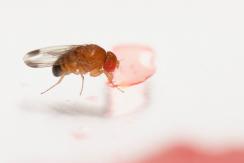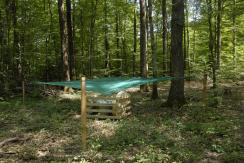Evolutionary Ecology
The department of Evolutionary Ecology gathers complementary skills in behavioural ecology, population dynamics, population biology, community ecology, and methodology (statistics and modelling). The research done in the department aims at studying how animal species evolve in a changing world by understanding the causes of the evolution of traits, adaptations and interactions. For that, we consider different levels of organization from individuals to populations and communities. Because organisms cannot be considered isolated from other biotic factors, we consider pathogens but also competing species within communities.
We study how individuals adapt to their environments that are largely impacted by anthropic pressures, and how life history traits and behaviour evolve in response to these pressures. Although we mainly focus on phenotype, we more and more consider the mechanistic link between the genotype and the phenotype. We develop the theoretical framework of our discipline through a conceptual and modeling approach. In parallel, we test hypotheses that arise from theoretical predictions through experimental, comparative and observational approaches on different biological models (insects, birds, mammals). Experimental approaches are developed in the laboratory (insect model) and in natura (bird, insect and mammal models). Observational and comparative research is mainly concerned with vertebrates. Our approaches are also, and increasingly, interested in the mechanisms of adaptive responses. In addition to the classical approaches of demographic analysis and trait change, methods of ecophysiology, chemical ecology and molecular biology are used.
Our department hosts several long-term studies of wild populations of different species. These long-term studies offer a valuable way to understand how biotic and abiotic factors affect individuals’ life history traits, and the functioning of populations in natura. Five populations of mammalian species are thus monitored for several years (more than 40 years on roe deer, 30 on Alpine marmots, 25 years on cats, 16 years on zebras, and 20 years on impala). Two of our study sites (La Sassière in Vanoise National Park (Alpine marmots) and Hwange National Park) have been certified as “Site d’Etude en Ecologie Globale” (SEEG), and two (ZA “Hwange” and ZA “Antarctic and sub-Antarctic”) were certified as “Zone Atelier” by the CNRS.
The department of Evolutionary ecology is also largely involved in training activities. Lastly, we also have strong socio-economic relationships. Indeed, because we address questions of major societal interest (global warming, public health) we tightly collaborate with socio-economic partners (Office Français de la Biodiversité, Vanoise National Park, Hwange National Park in Zimbabwe, Office National des Forêts, etc.) and participate to general public and media events.
Publications
Display of 691 to 720 publications on 2458 in total
The Role of Cognition in Social Information Use for Breeding Site Selection: Experimental Evidence in a Wild Passerine Population
Frontiers in Ecology and Evolution . 8
Journal article
see the publicationEffect of interspecific competition on species sensitivity distribution models: Analysis of plant responses to chemical stress
Ecotoxicology and Environmental Safety . 200 : 110722
Journal article
see the publicationA story of nasal horns: two new subspecies of Iguana Laurenti, 1768 (Squamata, Iguanidae) in Saint Lucia, St Vincent & the Grenadines, and Grenada (southern Lesser Antilles)
Zootaxa . 4608 ( 2 ) : 201
Journal article
see the publicationUtilisation de DRomics pour modéliser les données omiques de type dose-réponse dans le cadre de l’appréciation du risque environnemental
SEFA (Société d’Ecotoxicologie Fondamentale et Appliquée) .
Conference paper
see the publicationSome issues about the design of preclinical trials
Séminaire Celphedia (Création, ELevage, PHEnotypage, DIstribution et Archivage d'organismes modèles) .
Conference paper
see the publicationRefuges and context-dependent effect of anthropogenic structures on the stress level of a wild ungulate
Ecology and Behaviour .
Poster
see the publicationNew knowledge acquired from the French Alpine ibex (Capra ibex), a singular wild reservoir of Brucella infection
72th annual brucellosis Research Conference .
Poster
see the publicationGestion de la tuberculose bovine et des blaireaux Avis de l’Anse - Rapport d’expertise collective révisé
: 198
Report
see the publicationDRomics: an R tool for modelling omics dose-response data
Congrès useR! .
Poster
see the publicationDynamique de la brucellose chez le bouquetin des Alpes : un rôle majeur des femelles
37ème rencontres du GEEFSM .
Poster
see the publicationÉvolution temporelle 2013-2019 du foyer de brucellose dans la population de bouquetins des Alpes (Capra ibex) du massif du Bargy (Haute-Savoie, France)
37ème rencontres du GEEFSM .
Poster
see the publicationDisease management in wildlife populations: why is it so complex ?
Keynote lecture au congrès International Union of Game Biologists .
Conference paper
see the publicationComparison of the effect of alfaxalone VS medetomidine and ketamine for induction of anaesthesia in Trachemys scripta sp. undergoing sterilisation
Joint Leibniz-IZW/EAZWV/ECZM Zoo and Wildlife Health Conference .
Conference paper
see the publicationComplication-related variables in equine anaesthesia: a retrospective study on 1161 cases undergoing colic and non-colic surgery
AVA meeting .
Conference paper
see the publicationCombination of prior distributions elicited from expert opinions previous to Bayesian inference. Application to personalized medicine
Bayes 2019 (Bayesian Biostatistics conference) .
Conference paper
see the publicationA l’abri de la nuit : effet contexte-dépendant des perturbations anthropiques sur les niveaux de stress de chevreuils sauvages Capreolus capreolus
4ème Colloque d’Ecophysiologie Animale .
Conference paper
see the publicationFacteurs associés à la détection de Coxiella burnetii dans les prélèvements de poussière en élevages de ruminants domestiques
Bulletin de l'Académie Vétérinaire de France . 171 ( 3 ) : 216-222
DOI: 10.4267/2042/70286
Journal article
see the publicationBrucellosis dynamics in Alpine ibex: all caused by females?
Rencontres annuelles du LabEx Ecofect .
Poster
see the publicationRegional rainfall and local topography jointly drive tree community assembly in lowland tropical forests of New Caledonia
Journal of Vegetation Science . 30 ( 5 ) : 845-856
DOI: 10.1111/jvs.12781
Journal article
see the publicationPopulation dynamics in a structured habitat
Les Dossiers d'Agropolis International . 23 : 38-38
Journal article
see the publicationFunctional biogeography of dietary strategies in birds
Global Ecology and Biogeography . 28 ( 7 ) : 1004-1017
DOI: 10.1111/geb.12910
Journal article
see the publicationDisentangling the processes driving tree community assembly in a tropical biodiversity hotspot (New Caledonia)
Journal of Biogeography . 46 ( 4 ) : 796-806
DOI: 10.1111/jbi.13535
Journal article
see the publicationDistinguishing the signatures of local environmental filtering and regional trait range limits in the study of trait–environment relationships
Oikos . 128 ( 7 ) : 960-971
DOI: 10.1111/oik.05851
Journal article
see the publicationHybridization between Felis silvestris silvestris and Felis silvestris catus in two contrasted environments in France
Ecology and Evolution . 10 ( 1 ) : 263-276
DOI: 10.1002/ece3.5892
Journal article
see the publicationData gaps and opportunities for comparative and conservation biology
Proceedings of the National Academy of Sciences of the United States of America . 116 ( 19 ) : 9658-9664
Journal article
see the publicationEcologie évolutive, gestion et conservation des petits et méso-mammifères carnivores.
Modélisation biodynamique de l'accumulation de substances persistantes par des invertébrés benthiques d'eau douce
: 70
Report
see the publicationLong-term decline despite conservation efforts questions Eurasian Stone-curlew population viability in intensive farmlands
Ibis . 161 ( 2 ) : 359-371
DOI: 10.1111/ibi.12646
Journal article
see the publicationBiological Invasion Theories: Merging Perspectives from Population, Community and Ecosystem Scales
Biological Reviews .
Preprint
see the publicationA new multi-species method to correct for sampling bias in presence only niche models, and its application to Pl@ntNet citizen science data in France
ESA 2019 - Annual Meeting of the Ecological Society of America .
Conference paper
see the publication





You also, comment on this article